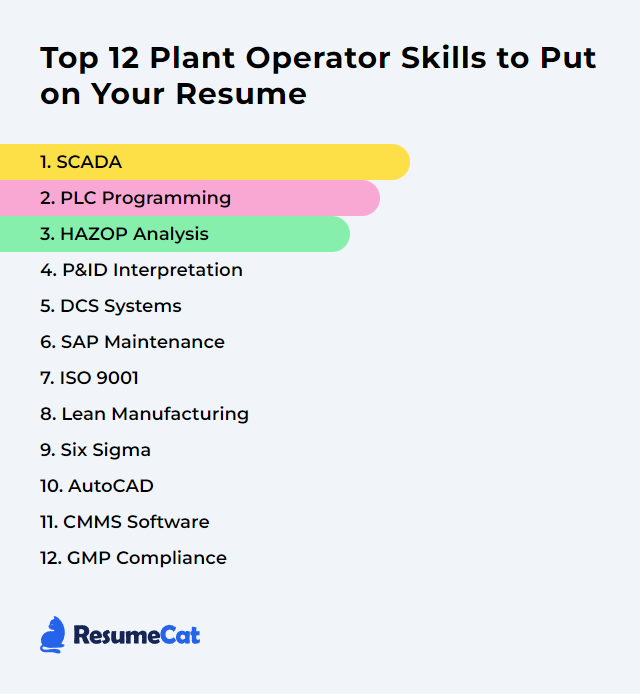Top 12 Plant Operator Skills to Put on Your Resume
Hiring managers skim fast. A plant operator’s resume gets noticed when it shows real-world skill, safety instincts, and the kind of technical fluency that keeps assets humming and downtime rare. Show the abilities that move the needle—controls, quality, maintenance, and the judgment to keep people and equipment out of trouble.
Plant Operator Skills
- SCADA
- PLC Programming
- HAZOP Analysis
- P&ID Interpretation
- DCS Systems
- SAP Maintenance
- ISO 9001
- Lean Manufacturing
- Six Sigma
- AutoCAD
- CMMS Software
- GMP Compliance
1. SCADA
SCADA (Supervisory Control and Data Acquisition) lets plant operators watch and steer processes in real time—collecting data, visualizing what’s happening, and sending commands that keep operations steady and safe.
Why It's Important
Without SCADA, you’re flying blind. With it, you gain immediate visibility, faster decisions, and a safer, more efficient plant with fewer surprises.
How to Improve SCADA Skills
Harden cybersecurity: Segment networks, apply least privilege, patch routinely, add MFA, and align with frameworks like IEC 62443 and NIST ICS guidance.
Design high-performance HMI: Simple, calm screens; consistent colors; clear trends; alarm rationalization per ISA-18.2 so true alarms stand out.
Build in resilience: Redundant servers, dual networks, heartbeat monitoring, and tested failover. Backups you can restore quickly, not just store.
Make data work: Historian tags with good naming, KPIs on dashboards, and analytics for condition monitoring and predictive maintenance.
Drill the team: Simulations, tabletop exercises, and periodic refreshers on abnormal situations and alarm floods.
Control changes: Formal change management, version control, tested updates, and disaster recovery runbooks that are actually used.
How to Display SCADA Skills on Your Resume
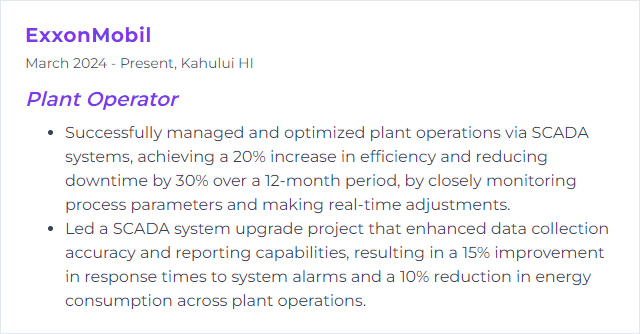
2. PLC Programming
PLC programming creates the logic that runs machines and processes. Think IEC 61131-3 languages (Ladder, Structured Text, Function Block) shaping reliable, safe, and efficient control.
Why It's Important
Automation does the heavy lifting. Solid PLC code trims errors, boosts throughput, and embeds safety into everyday operations.
How to Improve PLC Programming Skills
Master the fundamentals: Timers, counters, interlocks, scan cycles, task priorities—know them cold.
Use modern toolsets: Work fluently in Studio 5000, TIA Portal, GX Works, or Sysmac Studio. Simulation matters; test before touching hardware.
Write modular, readable code: UDTs, AOIs/FBs, state machines, and consistent naming. Version control your projects.
Design for safety: Safety PLCs and SIL concepts, safe states on loss of signal, thorough interlocks, and documented bypass procedures.
Diagnose fast: Trend key tags, structure fault handling, and add meaningful diagnostics that operators can act on.
Document everything: Rung comments, I/O lists, cause-and-effect charts, and clean HMI mappings.
How to Display PLC Programming Skills on Your Resume

3. HAZOP Analysis
HAZOP (Hazard and Operability Study) is a structured way to find what can go wrong by examining deviations from the design intent. Operators bring practical insight that spots real risks—and workable safeguards.
Why It's Important
It’s a safety net and a sharpening stone. You reduce incidents, learn the process deeply, and uncover improvements that pay back in uptime and quality.
How to Improve HAZOP Analysis Skills
Arrive prepared: Current PFDs, P&IDs, control narratives, SOPs, alarm philosophies, and equipment criticality lists.
Apply guide words well: No/More/Less/Reverse… explore credible deviations and consequences, not hypotheticals you can’t control.
Use a cross-functional team: Operations, maintenance, process, instrumentation, safety—diverse eyes catch different failure modes.
Connect to safeguards: Tie findings to IPLs and LOPA outcomes; verify alarms, trips, and mechanical protections are effective and tested.
Close the loop: Track actions, owners, and due dates; verify completion in the field, not just on paper.
Revalidate on change: Any MOC, project, or recurring issue is a trigger to revisit the study.
How to Display HAZOP Analysis Skills on Your Resume

4. P&ID Interpretation
P&IDs map the process universe—equipment, lines, valves, instruments, and control loops. Read them well and you can operate, troubleshoot, and isolate with confidence.
Why It's Important
Accurate interpretation shortens downtime, prevents missteps, and keeps interventions safe and precise.
How to Improve P&ID Interpretation Skills
Learn the standards: ISA/ISO symbols, line types, and instrument identification. Get fluent in conventions used on your site.
Trace the flow: Follow mediums from source to sink; note control valves, bypasses, and relief paths.
Decode tags: Equipment numbers, loop IDs, and revision notes. Understand how tags link to the DCS/PLC and field devices.
Connect to control: Read loop interactions, interlocks, permissives, and shutdown logic alongside the P&ID.
Validate in the field: Walkdowns expose mismatches, blocked valves, and missing labels you won’t see on paper.
How to Display P&ID Interpretation Skills on Your Resume

5. DCS Systems
Distributed Control Systems orchestrate large processes with central oversight, robust controllers, and operator-friendly HMIs. They’re the backbone of stable, scalable plants.
Why It's Important
Better control equals better outcomes—safety, quality, energy use, and throughput all benefit when the DCS is tuned and trusted.
How to Improve DCS Systems Skills
Modernize wisely: Keep firmware current, standardize templates, and retire brittle customizations that slow upgrades.
Secure the core: Defense-in-depth, application whitelisting, well-managed accounts, and tight remote access controls.
Raise HMI quality: High-performance graphics, alarm shelving and prioritization, consistent navigation, and situational awareness.
Add smart control: Advanced Process Control, better tuning, feedforward strategies, and constraint control where it pays back.
Integrate cleanly: OPC UA to historians, CMMS, and analytics. Data models that make downstream use easy.
Train on reality: Simulators and playbooks for startups, shutdowns, and upset recovery.
How to Display DCS Systems Skills on Your Resume
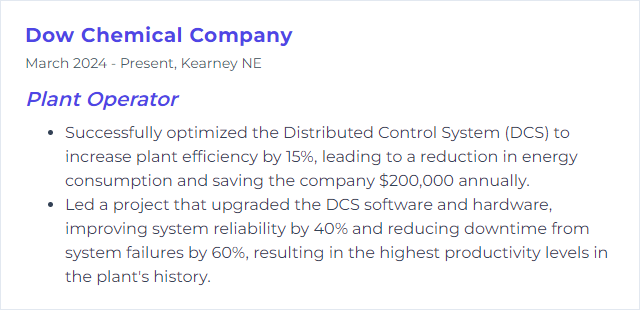
6. SAP Maintenance
SAP Maintenance (SAP PM/EAM, including S/4HANA) tracks assets, plans work, and records every wrench turn so equipment life and plant reliability trend up—not down.
Why It's Important
Good data drives good decisions. With clean master data and disciplined workflows, you prevent failures, control costs, and protect availability.
How to Improve SAP Maintenance Skills
Fix the foundation: Accurate equipment masters, hierarchies, task lists, BOMs, and measurement points.
Work the plan: Time-based and condition-based strategies, optimized cycles, and priority rules that match risk.
Go mobile: Real-time confirmations, parts usage, photos, and notes from the field—fewer delays and cleaner histories.
Measure what matters: MTBF, MTTR, schedule compliance, backlog health, and cost per asset on clear dashboards.
Automate flow: Notifications, approvals, and spares reservations that move without manual nudges.
Train by role: Planners, technicians, and supervisors need different screens, shortcuts, and reports.
How to Display SAP Maintenance Skills on Your Resume
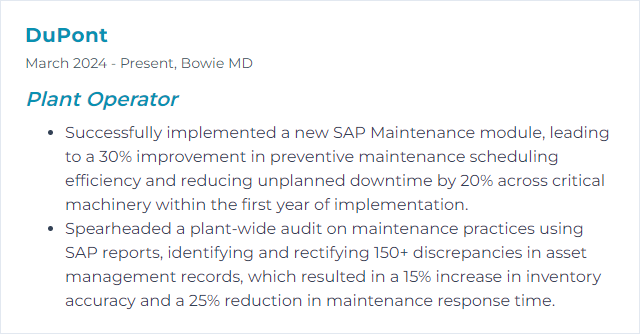
7. ISO 9001
ISO 9001 sets the framework for a quality management system focused on consistent delivery, customer satisfaction, and continuous improvement—grounded in risk-based thinking.
Why It's Important
For operators, it means clear processes, fewer defects, and a repeatable way to get work done right the first time.
How to Improve ISO 9001 Skills
Map processes: Define owners, inputs/outputs, and KPIs. Make flows easy to follow and audit-ready.
Audit with intent: Internal audits (per ISO 19011) that find gaps, not paperwork trivia. Then act.
Use CAPA ruthlessly: Root causes, targeted fixes, and effectiveness checks that stick.
Keep documents tight: Controlled procedures, current work instructions, and accessible records.
Engage people: Competency-based training, visible goals, and open feedback loops from customers and the floor.
Review at the top: Management reviews with real data and decisions, not a box-ticking ceremony.
How to Display ISO 9001 Skills on Your Resume
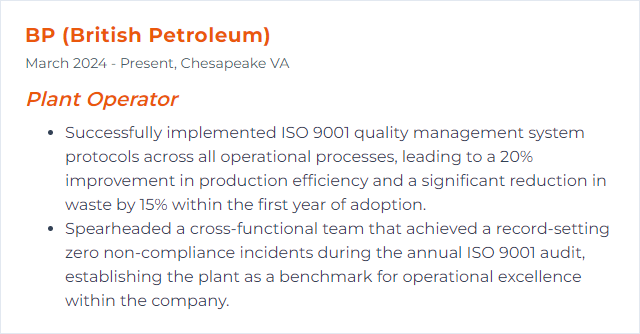
8. Lean Manufacturing
Lean removes waste and friction so flow improves. Less waiting, less motion, fewer defects—more value with less effort.
Why It's Important
Operators feel it daily: cleaner work areas, smoother changeovers, predictable output, and fewer firefights.
How to Improve Lean Manufacturing Skills
See the value stream: Map processes end-to-end; expose bottlenecks and wasted steps.
Make 5S a habit: Sort, set in order, shine, standardize, sustain—simple, powerful, relentless.
Cut changeover time: SMED thinking reduces setups and unlocks flexibility.
Standard work: Best-known method documented, trained, and improved in small bites.
Flow and pull: JIT, Kanban, and right-sized batches that actually move.
Poka‑Yoke: Mistake-proof where you can; make errors hard to make and easy to spot.
Daily problem solving: Gemba walks, tier meetings, and 5 Whys that drive fixes, not blame.
How to Display Lean Manufacturing Skills on Your Resume
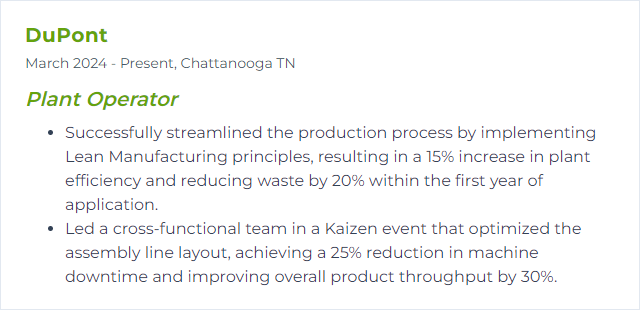
9. Six Sigma
Six Sigma uses data to squeeze variation and defects out of processes. DMAIC, control plans, and statistical tools keep improvements real and sustained.
Why It's Important
Higher yield, steadier quality, and fewer do-overs. That’s more product with less waste.
How to Improve Six Sigma Skills
Frame the work: Define CTQs, draft a SIPOC, and scope projects that matter.
Trust the data: MSA for gauges, clean data collection, and honest baselines.
Use the math: SPC charts, hypothesis tests, regression, and DOE when cause-effect isn’t obvious.
Control the gain: Standardized work, mistake-proofing, and visual controls to hold improvements.
Blend with Lean: Lean clears waste; Six Sigma tames variation. Together they stick.
Build capability: Green/Black Belt skills, mentoring, and a simple benefits tracker to prove value.
How to Display Six Sigma Skills on Your Resume
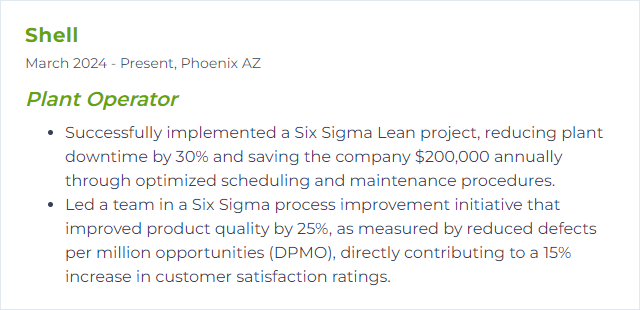
10. AutoCAD
AutoCAD delivers precise 2D/3D drawings for layouts, piping, and equipment. With Plant 3D, you can build specs, models, and isometrics that match the real world.
Why It's Important
Good drawings shorten installs, reduce rework, and make maintenance safer and faster.
How to Improve AutoCAD Skills
Get fast with fundamentals: Commands, shortcuts, snaps, and grips. Speed matters.
Standardize wisely: Templates, layers, blocks, xrefs, and naming conventions everyone follows.
Scale and annotate cleanly: Annotative text, dimensions, and title blocks that stay legible.
Go 3D when it helps: Use Plant 3D for specs, orthos, and isos; spot clashes before steel is cut.
Collaborate: Shared DWG standards, reference files, and controlled revisions in a common data environment.
Practice with purpose: Recreate plant areas, then review with maintenance to refine.
How to Display AutoCAD Skills on Your Resume

11. CMMS Software
CMMS keeps maintenance organized—work orders, PMs, parts, and asset histories in one place. Less chaos, more control.
Why It's Important
It shrinks downtime, sharpens planning, and reveals where time and money actually go.
How to Improve CMMS Software Skills
Make it easy to use: Clean screens, sensible fields, mobile access offline. If it’s clunky, data will be too.
Fit the workflow: Statuses, approvals, and notifications configured to how the plant really works.
Integrate the stack: Tie into ERP for parts and costs, and connect sensors/SCADA via OPC/REST for condition-based work.
Control spares: Min-max levels, critical spares lists, and reservation rules to prevent stockouts.
Lean on analytics: Dashboards for backlog, compliance, failure modes, and asset health. Decide with facts.
Train and support: Short, role-based guides and quick help when something breaks.
Stay compliant: Time-stamped records, audit trails, and sign-offs that stand up to scrutiny.
How to Display CMMS Software Skills on Your Resume

12. GMP Compliance
GMP (Good Manufacturing Practice) keeps products safe and consistent. It’s about disciplined processes, data integrity, and controls that catch problems before they reach a customer.
Why It's Important
Compliance protects people and the brand. It reduces recalls, failures, and the costly churn of rework.
How to Improve GMP Compliance Skills
Know the rules: FDA, EMA, and ICH Q-series expectations relevant to your operation.
Write it, do it, prove it: Clear SOPs, executed as written, with records that meet ALCOA+ principles.
Control change: Formal MOC, deviation handling, and CAPA that addresses root causes.
Qualify and validate: IQ/OQ/PQ, cleaning validation, and periodic requalification on a set cadence.
Watch the environment: Calibration, sanitation, and environmental monitoring programs that actually trend and trigger action.
Train relentlessly: Role-based competency, hygiene, and gowning practices checked and refreshed.
Audit to improve: Internal audits that surface issues early and verify fixes hold.
How to Display GMP Compliance Skills on Your Resume

